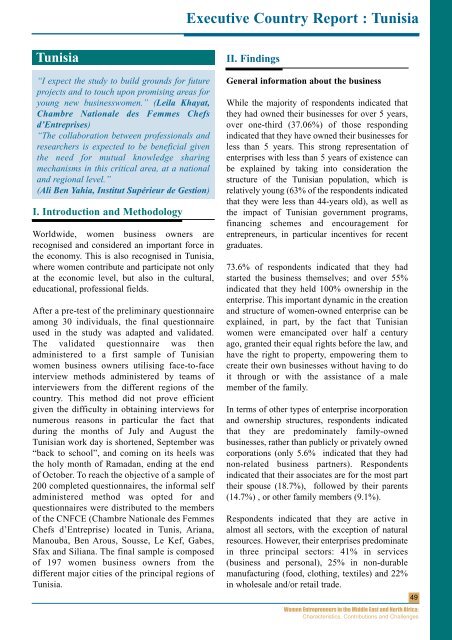Women Entrepreneurs in the Middle East and North Africa: - CAWTAR
Women Entrepreneurs in the Middle East and North Africa: - CAWTAR
Women Entrepreneurs in the Middle East and North Africa: - CAWTAR
Create successful ePaper yourself
Turn your PDF publications into a flip-book with our unique Google optimized e-Paper software.
Tunisia<br />
“I expect <strong>the</strong> study to build grounds for future<br />
projects <strong>and</strong> to touch upon promis<strong>in</strong>g areas for<br />
young new bus<strong>in</strong>esswomen.” (Leila Khayat,<br />
Chambre Nationale des Femmes Chefs<br />
d’Entreprises)<br />
“The collaboration between professionals <strong>and</strong><br />
researchers is expected to be beneficial given<br />
<strong>the</strong> need for mutual knowledge shar<strong>in</strong>g<br />
mechanisms <strong>in</strong> this critical area, at a national<br />
<strong>and</strong> regional level.”<br />
(Ali Ben Yahia, Institut Supérieur de Gestion)<br />
I. Introduction <strong>and</strong> Methodology<br />
Worldwide, women bus<strong>in</strong>ess owners are<br />
recognised <strong>and</strong> considered an important force <strong>in</strong><br />
<strong>the</strong> economy. This is also recognised <strong>in</strong> Tunisia,<br />
where women contribute <strong>and</strong> participate not only<br />
at <strong>the</strong> economic level, but also <strong>in</strong> <strong>the</strong> cultural,<br />
educational, professional fields.<br />
After a pre-test of <strong>the</strong> prelim<strong>in</strong>ary questionnaire<br />
among 30 <strong>in</strong>dividuals, <strong>the</strong> f<strong>in</strong>al questionnaire<br />
used <strong>in</strong> <strong>the</strong> study was adapted <strong>and</strong> validated.<br />
The validated questionnaire was <strong>the</strong>n<br />
adm<strong>in</strong>istered to a first sample of Tunisian<br />
women bus<strong>in</strong>ess owners utilis<strong>in</strong>g face-to-face<br />
<strong>in</strong>terview methods adm<strong>in</strong>istered by teams of<br />
<strong>in</strong>terviewers from <strong>the</strong> different regions of <strong>the</strong><br />
country. This method did not prove efficient<br />
given <strong>the</strong> difficulty <strong>in</strong> obta<strong>in</strong><strong>in</strong>g <strong>in</strong>terviews for<br />
numerous reasons <strong>in</strong> particular <strong>the</strong> fact that<br />
dur<strong>in</strong>g <strong>the</strong> months of July <strong>and</strong> August <strong>the</strong><br />
Tunisian work day is shortened, September was<br />
“back to school”, <strong>and</strong> com<strong>in</strong>g on its heels was<br />
<strong>the</strong> holy month of Ramadan, end<strong>in</strong>g at <strong>the</strong> end<br />
of October. To reach <strong>the</strong> objective of a sample of<br />
200 completed questionnaires, <strong>the</strong> <strong>in</strong>formal self<br />
adm<strong>in</strong>istered method was opted for <strong>and</strong><br />
questionnaires were distributed to <strong>the</strong> members<br />
of <strong>the</strong> CNFCE (Chambre Nationale des Femmes<br />
Chefs d’Entreprise) located <strong>in</strong> Tunis, Ariana,<br />
Manouba, Ben Arous, Sousse, Le Kef, Gabes,<br />
Sfax <strong>and</strong> Siliana. The f<strong>in</strong>al sample is composed<br />
of 197 women bus<strong>in</strong>ess owners from <strong>the</strong><br />
different major cities of <strong>the</strong> pr<strong>in</strong>cipal regions of<br />
Tunisia.<br />
Executive Country Report : Tunisia<br />
II. F<strong>in</strong>d<strong>in</strong>gs<br />
General <strong>in</strong>formation about <strong>the</strong> bus<strong>in</strong>ess<br />
While <strong>the</strong> majority of respondents <strong>in</strong>dicated that<br />
<strong>the</strong>y had owned <strong>the</strong>ir bus<strong>in</strong>esses for over 5 years,<br />
over one-third (37.06%) of those respond<strong>in</strong>g<br />
<strong>in</strong>dicated that <strong>the</strong>y have owned <strong>the</strong>ir bus<strong>in</strong>esses for<br />
less than 5 years. This strong representation of<br />
enterprises with less than 5 years of existence can<br />
be expla<strong>in</strong>ed by tak<strong>in</strong>g <strong>in</strong>to consideration <strong>the</strong><br />
structure of <strong>the</strong> Tunisian population, which is<br />
relatively young (63% of <strong>the</strong> respondents <strong>in</strong>dicated<br />
that <strong>the</strong>y were less than 44-years old), as well as<br />
<strong>the</strong> impact of Tunisian government programs,<br />
f<strong>in</strong>anc<strong>in</strong>g schemes <strong>and</strong> encouragement for<br />
entrepreneurs, <strong>in</strong> particular <strong>in</strong>centives for recent<br />
graduates.<br />
73.6% of respondents <strong>in</strong>dicated that <strong>the</strong>y had<br />
started <strong>the</strong> bus<strong>in</strong>ess <strong>the</strong>mselves; <strong>and</strong> over 55%<br />
<strong>in</strong>dicated that <strong>the</strong>y held 100% ownership <strong>in</strong> <strong>the</strong><br />
enterprise. This important dynamic <strong>in</strong> <strong>the</strong> creation<br />
<strong>and</strong> structure of women-owned enterprise can be<br />
expla<strong>in</strong>ed, <strong>in</strong> part, by <strong>the</strong> fact that Tunisian<br />
women were emancipated over half a century<br />
ago, granted <strong>the</strong>ir equal rights before <strong>the</strong> law, <strong>and</strong><br />
have <strong>the</strong> right to property, empower<strong>in</strong>g <strong>the</strong>m to<br />
create <strong>the</strong>ir own bus<strong>in</strong>esses without hav<strong>in</strong>g to do<br />
it through or with <strong>the</strong> assistance of a male<br />
member of <strong>the</strong> family.<br />
In terms of o<strong>the</strong>r types of enterprise <strong>in</strong>corporation<br />
<strong>and</strong> ownership structures, respondents <strong>in</strong>dicated<br />
that <strong>the</strong>y are predom<strong>in</strong>ately family-owned<br />
bus<strong>in</strong>esses, ra<strong>the</strong>r than publicly or privately owned<br />
corporations (only 5.6% <strong>in</strong>dicated that <strong>the</strong>y had<br />
non-related bus<strong>in</strong>ess partners). Respondents<br />
<strong>in</strong>dicated that <strong>the</strong>ir associates are for <strong>the</strong> most part<br />
<strong>the</strong>ir spouse (18.7%), followed by <strong>the</strong>ir parents<br />
(14.7%) , or o<strong>the</strong>r family members (9.1%).<br />
Respondents <strong>in</strong>dicated that <strong>the</strong>y are active <strong>in</strong><br />
almost all sectors, with <strong>the</strong> exception of natural<br />
resources. However, <strong>the</strong>ir enterprises predom<strong>in</strong>ate<br />
<strong>in</strong> three pr<strong>in</strong>cipal sectors: 41% <strong>in</strong> services<br />
(bus<strong>in</strong>ess <strong>and</strong> personal), 25% <strong>in</strong> non-durable<br />
manufactur<strong>in</strong>g (food, cloth<strong>in</strong>g, textiles) <strong>and</strong> 22%<br />
<strong>in</strong> wholesale <strong>and</strong>/or retail trade.<br />
49<br />
<strong>Women</strong> <strong>Entrepreneurs</strong> <strong>in</strong> <strong>the</strong> <strong>Middle</strong> <strong>East</strong> <strong>and</strong> <strong>North</strong> <strong>Africa</strong>:<br />
Characteristics, Contributions <strong>and</strong> Challenges


